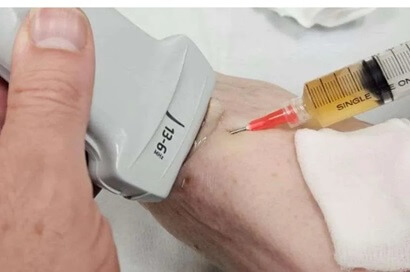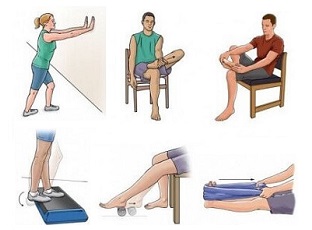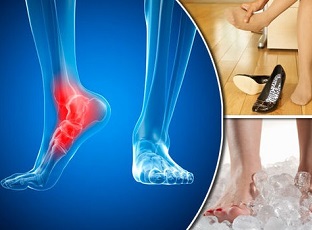- Home
- Common Foot Problems
- Ganglion Cyst
Ganglion Cyst Foot
Written By: Chloe Wilson BSc(Hons) Physiotherapy
Reviewed By: FPE Medical Review Board

A ganglion cyst foot is a small, harmless fluid-filled lump that forms on the foot.
These jelly-filled bags usually form around a tendon or joint, and may fluctuate in size. Often they are completely painless, but they can cause pain, tenderness and affect foot movement.
Ganglion cysts are the most common cause of a lump on top of the foot, but they can develop anywhere around the foot, ankle or toes.
The exact cause of foot ganglion cysts is often unknown but may be linked to foot injuries, repetitive stress or irritation of the foot structures, age and gender.
There are a range of treatment options for ganglion foot cysts such as rest, orthotics and exercises but more persistent and severe cases may require aspiration or surgery.
Here we will look at what a ganglion cyst foot is, common causes and symptoms, how they diagnosed and the best treatment options.
What is a Ganglion Cyst?

A ganglion cyst is a small fluid-filled lump that usually develop near tendons or joints.
These small pockets typically sit just underneath the skin, forming a round or oval-shaped lump that you can see and/or feel.
They can also occur deeper under the skin and may not be noticeable, particularly underneath the foot.
Ganglion cysts are filled with synovial fluid, the thick, jelly-like lubricating fluid found in joints. They tend to balloon out from a joint or tendon sheath. Any disruption in the normal production or distribution of synovial fluid cause excess fluid to collect around the joint or tendon, forming a cyst. Ganglion cysts are benign soft tissue masses, they are not cancerous.
The most common place to find a ganglion cyst is in the wrist/hand but around 11% of all cases are actually foot ganglion cysts. Ganglion cysts are one of the most common causes of a lump on top of the foot, but they can occur anywhere in the foot including around the ankle or underneath the foot.
A ganglion cyst foot may or may not cause pain depending on its size and location.
What Causes Foot Ganglion Cysts?
While the exact cause of foot ganglion cysts isn't always clear, there are several factors that may contribute to their development including:
- Joint or Tendon Irritation: Ganglion cysts often form near joints or tendons, and repetitive irritation or stress to these areas can lead to the development of a cyst e.g. repeated motion or pressure on the foot.
- Trauma or Injury: e.g. sprain or direct impact, can trigger the formation of a ganglion cyst as part of the body’s healing process.
- Joint or Tendon Degeneration: e.g. arthritis or other inflammatory joint conditions may increase the likelihood of foot ganglion cyst
- Synovial Fluid Abnormalities: any disruption in the production or distribution of synovial fluid can cause a ganglion cyst foot to form
- Connective Tissue Disorders: Individuals with connective tissue disorders or genetic predispositions that affect the strength and integrity of joint structures may be more prone to developing ganglion cysts.
- Repeated Stress: Activities that subject the foot to repeated stress or micro trauma, such as certain types of exercise or occupational activities, may increase the likelihood of ganglion cysts on the foot.
- Age & Gender: Ganglion cysts in the foot are most common between the ages of 20-40 and are more common in women than men.
- Previous Ganglions: if you have had a ganglion cyst in the past, you are at increased risk of developing further cysts.
- Vitamin Deficiency: There has been recent speculation that deficiencies in certain vitamins e.g. B6, B12 and vitamin D may contribute to ganglion cyst foot formation but further research is needed to confirm this.
Foot Ganglion Cyst Symptoms
Common symptoms of ganglion cysts on the foot include:
- Lump: Small lump around 1-3cm wide – think small pea to golf ball size, usually round or oval shaped. Soft or firm to touch and moves freely. A lump is the most common symptom of a ganglion cyst foot
- Pain or Discomfort: Dull aching pain that is worse when applying pressure to the ganglion cyst e.g. when wearing shoes. Not all foot ganglion cysts cause pain – more likely to when located underneath the foot than on top
- Increased Pain with Activity: Pain and discomfort may intensify during activities that involve movement of the foot or increased pressure on the cyst e.g. walking, running, or standing for extended periods.
- Numbness or Tingling: if the ganglion foot cyst presses on one of the surrounding foot nerves it can cause pins and needles, burning or numbness in the foot and toes.
- Changes in Cyst Size: The size of the ganglion cyst can fluctuate over time. It may become larger or smaller, and the symptoms may correspondingly worsen or improve.
How Is A Foot Ganglion Cyst Diagnosed?
Your doctor will diagnose a ganglion cyst foot by carrying out a detailed examination. They will start by asking you questions about the lump e.g. when you noticed it, has it changed, symptoms, any associated problems and previous injuries.
They will then examine your foot, looking at things such as the movement and strength in the foot and any areas of swelling, redness or tenderness. They will palpate the lump to assess its size, what it feels like, any tenderness and how it moves. They may also shine a light through the cyst to confirm if it is a solid lump or filled with fluid.
You may also be sent for further imaging such as an ultrasound or MRI scan to confirm the diagnosis and to see if the ganglion foot cyst is causing any other problems such as nerve compression. In some cases, your doctor may remove some of the fluid from the lump for evaluation, known as aspiration. Fluid from a ganglion cyst foot is usually thick and clear.
Differential Diagnosis
Ganglion cysts are one of the most common causes of a lump on the foot, but there are other things that can present in a similar way:
- Digital Mucous Cyst: small pocket of fluid, often on the toes
- Bone Spurs: hard lumps from excess bone growth
- Gout Foot: inflammation, redness and intense pain around the big toe
- Lipoma: small lump of fatty tissue just underneath the skin
- Bunion: hard lump on outside of foot with toe deviation
- Corns/Calluses: thickened, raised areas of skin
- Plantar Warts: small, rough lumps with tiny black dots on the skin
Ganglion Cyst Foot Treatment
There are a number of treatment options for a foot ganglion cyst depending on the size, location and symptoms:
Conservative Treatment
- Monitor: if the ganglion cyst foot is not causing any problems i.e. no pain and not affecting daily activities, then no direct treatment is required
- Rest: Avoid any activities that aggravate the cause foot pain
- Footwear: switch to wider, cushioned shoes to reduce pressure and friction on the ganglion cyst lump
- Orthotics: special inserts for your shoes that correct any abnormal foot positions and take pressure off the ganglion. A physical therapist or podiatrist can advise you on what orthotics would be most beneficial for you
- Foot Exercises: Exercises to improve the strength and flexibility of the foot can help to improve foot movements and may reduce symptoms from a foot ganglion cyst. Addressing areas of weakness, tightness and stiffness can reduce the pressure on a ganglion, helping to reduce pain and in some cases the size of the cyst.
Aspiration

If you are in severe pain or your daily activities are limited, your doctor may drain the fluid from your foot ganglion cyst, known as aspiration.
The surrounding area is numbed with local anaesthetic and a needle is inserted into the cyst and used to drain the fluid. This may be done under ultrasound guidance to ensure correct positioning of the needle.
Aspiration may be combined with a steroid injection where a corticosteroid is injected into the cyst to help relieve pain and inflammation.
Aspiration helps to ease the symptoms of a ganglion cyst foot but the recurrence rate is around 50%. This is because the connection between the cyst and the joint or tendon sheath, think of it like a root, is not removed with aspiration so the fluid often re-collects.
Ganglion Cyst Foot Surgery
Surgical treatment for a ganglion cyst foot may be recommended if:
- Symptoms Are Affecting Daily Life: e.g. severe pain or limiting mobility
- Limited Response To Non-Surgical Treatment: no improvement with 3-6 months of conservative treatment
- Recurrence Following Aspiration: the ganglion foot cyst regrows. You may have the cyst aspirated multiple times before opting for surgery

Ganglion cyst foot surgery, aka ganglion resection, is usually carried out under local anaesthetic.
A small incision is made and the ganglion cyst is removed, as well as its root – the part that connects the cyst to the joint or tendon sheath.
The wound is then closed with stitches and a dressing and bandaged applied. You can go home the same day. You may be given a boot or splint to wear for a few days and may need to use crutches initially, to keep the weight off your foot.
Recovering From Surgery
You may need to rest your foot for a few days following surgical removal of a ganglion cyst foot.
Ideally, you want to keep your foot elevated above the level of your heart to help reduce any swelling. Either prop your leg up on cushions or try a specially designed leg elevation cushion. It can also help to apply ice regularly to reduce pain and swelling.
After 10-14 days, the stitches will be removed. At this stage, you should be able to start driving again and return to work, depending on your occupation.
It may take 2-6 weeks to fully recover from ganglion cyst foot surgery.
Ganglion cyst foot surgery is usually fairly straightforward but any surgery does carry risks such as infection (1%), nerve damage (5%) and recurrence of the ganglion cyst (20%). There will be a scar over the area and there may occasionally be some ongoing pain or stiffness in the foot, depending on the location of the cyst.
Ganglion Cyst Foot Summary
- A foot ganglion cyst is a small, mobile, fluid-filled lump that typically occurs around one of the foot joints or tendon sheaths. They are completely harmless.
- Ganglion cysts may cause a dull, aching pain that gets worse with activity or pressure, but may be entirely painless. The size of the lump may fluctuate.
- The exact cause of foot ganglion cysts is unknown but may be related to previous foot injuries, local irritation or degeneration, age, gender or repetitive pressure/friction
- Most ganglion foot cysts can be treated at home with a combination of time, rest, exercises and orthotics.
- More persistent cases of ganglion foot cysts may require aspiration or excision surgery
- Ganglion cysts are the most common cause of a lump on top of the foot
You may also be interested in the following articles:
- Pain On Top Of Foot
- Side Foot Pain
- Foot Arch Pain
- Foot Lumps & Bumps
- Burning Pain In Foot
- Foot Pain Diagnosis Chart
Related Articles
Page Last Updated: 19th November, 2024
Next Review Due: 19th November, 2026






